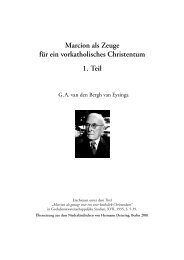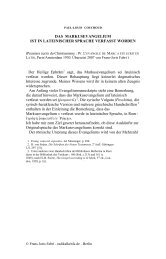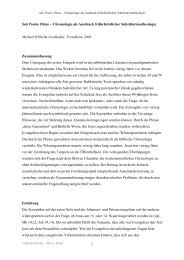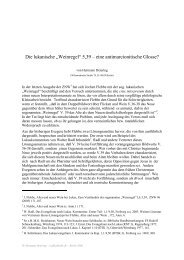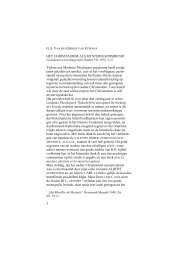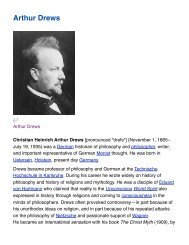Arthur Drews - Radikalkritik
Arthur Drews - Radikalkritik
Arthur Drews - Radikalkritik
Create successful ePaper yourself
Turn your PDF publications into a flip-book with our unique Google optimized e-Paper software.
- 4 -that <strong>Drews</strong>'s supporters caused a sensation by plastering the town's billboards withposters asking, Did Jesus Christ ever live? According to the newspaper his argumentswere so graphic that several women had to be carried from the hall screaminghysterically, while one woman stood on a chair and invited God to strike himdown.[5][6]On Feb 20, 1910, a counter confrontation took place in the Bush Circus. The followingyear, on March 12, 1911 another follow-up debate was organized.[7]To discuss <strong>Drews</strong>'s thesis, Albert Schweitzer added two new chapters (22 and 23: TheDebate about the Historicity of Jesus) in the second edition of his Quest of theHistorical Jesus (1913).[8]2 The Witnesses to the Historicity of Jesus (1912)2.1 Critique of Circular Historical Theology and its Sentimental Lives of Jesus<strong>Arthur</strong> <strong>Drews</strong> published a second part to his book, Die Christusmythe II: "DieZeugnisse für die Geschichtlichkeit Jesu" (1911), to answer objections of scholars andcritically examine the historical method of theologians. Joseph McCabe (1867–1955), aformidably gifted linguist, orator, writer and translator,[9] who started life as a RomanCatholic priest, produced a first-class translation as The Witnesses to the Historicity ofJesus (1912), published both in London and Chicago.The Preface of this classic book states: [10]"The question of the historicity of Jesus ["die Frage nach der Historizität von JesusChristus"] is a purely historical question" to be "settled with the resources of historicalresearch".<strong>Drews</strong> denounces The Quest for the Historical Jesus, which had been the rage sinceDavid Strauss (1808–1874). He criticizes "historical theology" as not respecting therules of non-Christian historical method, and giving way to sentimental intuitionsand basic circularity of argumentation, where the existence of Jesus ispresupposed, but not evidenced by outside sources.<strong>Drews</strong>, like Schweitzer in his Quest, focuses mostly on German liberal theologians,similarly ignoring Baron d'Holbach (1723–1789), the first to publish a critical Life ofJesus, with his Histoire critique de Jésus-Christ, ou Analyse raisonnée des évangiles(1770), translated as Ecce Homo.[11] But he does briefly mention Ernest Renan(1823–1892), en passant, whereas Schweitzer had devoted a full chapter 13 to theFrench "theology historian" and his popular Vie de Jésus (1863)[12]2.2 (I) The Jewish Witnesses1. Philo: a Jewish contemporary of Jesus, knew of the Essenes, but makes no mentionof Jesus or Christians.[14]2. Justus of Tiberias: <strong>Drews</strong> mentions the curious case of Photius, the 9th centuryPatriarch of Constantinople, who became famous for his Bibliotheca or Myriobiblon, acollection of excerpts and summaries of some 280 classical volumes now mostly lost.Photius read through the Chronicle of Justus of Tiberias, a contemporary of Josephus,who went through the Jewish War and the destruction of Jerusalem. Justus wrote abook about the War, and a Chronicle of the Jewish people from Moses to Agrippa II(27-ca. 94 AD). "Photius himself believed there ought to be some mention ofJesus [in Justus's Chronicle], and was surprised to find none."[14]3. Josephus: pros and cons of the famous passage Testimonium Flavanium,concluding it is most likely an interpolation or alteration.[15]4. Talmud: offers no contemporary report on Jesus, only later fragments from theGospel tradition.[16]


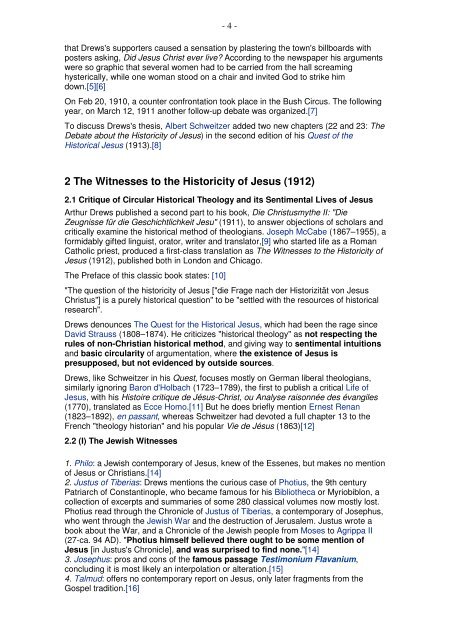

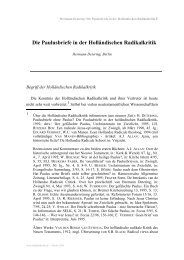
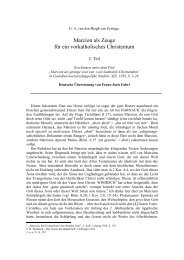

![[1] quibus tamen interfuit et ita posuit - Radikalkritik](https://img.yumpu.com/28285180/1/184x260/1-quibus-tamen-interfuit-et-ita-posuit-radikalkritik.jpg?quality=85)
